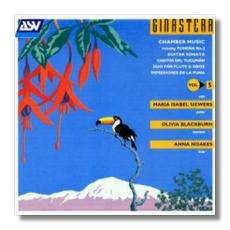
The Internet's Premier Classical Music Source
Related Links
- Ginastera Reviews
- Latest Reviews
- More Reviews
-
By Composer
-
Collections
DVD & Blu-ray
Books
Concert Reviews
Articles/Interviews
Software
Audio
Search Amazon
Recommended Links
Site News
 CD Review
CD Review
Alberto Ginastera

Chamber Music - Volume 5
- Cantos del Tucumán
- Danza del Trigo
- Estancia: Triste Pampeano ^
- Guitar Sonata
- Puneña #2
- Duo for Flute and Oboe
- Danza Criolla (arr. Barbosa-Lima)
- Milonga (arr. Mercado)
- Impresiones de la Puna
Olivia Blackburn, soprano
Anna Noakes, flute
David Emanuel, violin
Gillian Tingay, harp
Gary Kettel, percussion
John Anderson, oboe
Christopher van Kampen, cello
Mariá Isabel Siewers, guitar
Rafael Gintoli, violin
Lyric String Quartet
Academy Sound & Vision CDDCA1103 59:07
Summary for the Busy Executive: Music that should be better known.
Most critics, if not the general public, now consider Argentinean Alberto Ginastera (pronounced by him "JEAN-a-STAIR-a," rather than "HEEN-a-STAIR-a"; the name is Italian, not Spanish) the best composer Latin America has so far produced. Ginastera had his success early, with the ballet Estancia, which probably remains his most popular piece. His output falls into three periods: pre-Estancia; an application of Bartók's approach to folklore to create a nationalist Argentinean music; dodecaphony and beyond. Among critics, his greatest notice came in the Sixties to about 1971, with the premières of his first piano concerto and the Expressionist operas Don Rodrigo, Bomarzo, and Beatrix Cenci, after which interest seemed to diminish, although he still got prestigious commissions.
Like Stravinsky, Ginastera worked very slowly and very carefully. I admit to losing interest around the time of Beatrix Cenci (which - in the interest of full disclosure - I confess I haven't heard). I love his overtly nationalist phase, but his last period disappointed me, perhaps because he didn't give me another Variaciones Concertante or First Piano Concerto. However, even in works that leave me cold, I have to admit his craft.
This CD gives us Ginastera early, middle, and late. The Cantos del Tucumán, written at 22 for soprano, flute, violin, harp, and two Indian drums, shows us the beauty and precision of Ginastera's sonic imagination. The idiom differs from the one you think of when Ginastera's name pops up, closer to writers like Ravel and Roussel, rather than to Stravinsky or Bartók. Nevertheless, the songs haunt you. The Indian drums especially fascinate. I regard this as one of the composer's most purely gorgeous works.
As I may have already implied, I view much of late Ginastera as a decline. The pieces are never badly written, but they seem obligatory, something to fill a commission, rather than a necessary expression of some artistic need - the 1976 Puneña #2 for solo cello, for example, written on a request from Rostropovich to celebrate conductor and patron Paul Sacher's 70th birthday. It works out a theme based on Sacher's name - Eb (eS)/A/C/B (H, in the German notational system)/E/D ("re") - and that to me sums up its entire interest. The guitar sonata from the same year, however, counts as a happy exception. Indeed, I can't think of a better or more substantial guitar work other than the Bach lute suites or the Dowland fantasias. The sonata seems to get at the "soul" of the instrument, and the sound of the strummed open strings dominates the piece. The scherzo, a brilliant, mercurial phantasmagoria of half-lights and shades incorporates Beckmesser's "Laud" from Meistersinger. What is, after all, a crude joke at someone's expense in the original becomes a beautiful, poetic thing in Ginastera's hands. It's the music in Beckmesser's soul, rather than the music he actually could write.
The Duo for flute and oboe (1945) mines a lot of music from very small forces. Ginastera even manages to get a fugue going in the last movement. If the players work it right, they can achieve the illusion of more than two parts from two melody instruments. The slow movement - like most of Ginastera's slow movements - seems to express the essence of solitude, someone alone with their thoughts.
The Impresiones de la Puna for flute and string quartet Ginastera never officially owned to. He considered it a student work. It may not have the snap or elegance of the mature composer, but it's a lovely work, very Impressionistic - indeed, more so than the Cantos del Tucumán. I'm happy it's recorded.
Transcriptions for the guitar of other works, including Estancia, round out the disc. They're nice and guitarists looking for material would do well to take them up. However, I do prefer the originals.
The performers do well, with soprano Olivia Blackburn in the Cantos and guitarist Mariá Isabel Siewers in the sonata making a stronger impression. Blackburn's voice gets inside you. Siewers goes beyond overcoming the sonata's significant technical difficulties and begins to shape the poetry. The disc mixes what I would call Pleasant Listening with demands on your full attention, so the program strikes me as a bit odd. Nevertheless, I enjoyed it quite a bit.
Copyright © 2004, Steve Schwartz



















